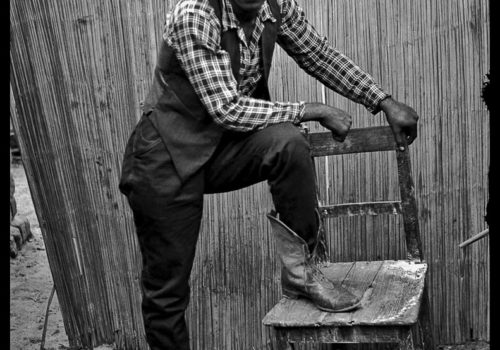Maison Revue Noire presents the first Jean Depara’s retrospective (1928-1997). Each of these 150 photographies show the Leopoldville (later Kinshasa) bars/dancings crazy nights when the country access to the independance. Everyone experiences those moments when the modern world finally becomes accessible to them, regardless of wether Black or white. In Leopoldville, later knows as Kinshasa, this is taken for the “American way of life”, its cars and fashionablr Bills in cowboy outfits, the electric guitars, sax and the music that takes the merengue, the cha cha cha and above all the rumba into a mad dance known word-wide as “Zairian music”. The bands of young Kinshasans, each with their own distinctive attire and their female muses, attend frequently the inumerable bars/dancing halls, support a music band here, Franco’s “Ok Jazz”, another one there, Joseph Kabasele’s “African Jazz”. Athletes, proud of their bodies, parade before their admirers at the pool of the Funa sports complex. That is the scenery and the lifestyle of wich the photographer Depara make us partake with each one of his images.
Jean Depara joined in 1951 the capital of Belgian Congo, Léopoldville (then called Kinshasa) and saw various businesses: the Bata shoe factory, repairing watches and cameras …Depara is also a photographer with his camera Adox 6×6 and 6×8 bought for his wedding in 1950. Day or night, from 1951 to 1975, Depara photographs atmosphere od dancing-bars and clubs but also athletes and gangs of well outfits youths named «sapeurs». The megalopolis Kinshasa is then the African city where the music is spreading across the continent and the world. He is the friend of all musicians and especially Franco, the future maestro of Zairean rumba, who asked in 1954 to be his appointed photographer.
And it’s the scenery and the life the photographer Depara share us in each of his images. He runs this universe in which he is himself one of the actors : with his camera, he is there as well as girls, lovers loving, musicians, bartenders alluring of the Kongo Bar or the Opika, the Champs-Elysées or La perruche Bleue.
In 1956, he opened a studio Depara humorously named «Jean Whisekys Depara» much to meet the demands for «complete» some operations of seduction. It will close in 1966 as his life, his pleasure to passing by outside photography with his friends, his buddies and his conquests. At that time, he lives comfortably, with convertible and villa.
In the 1970s, times are getting tougher. Depara do not like the «color images made without relief» he said. he does not like automatic photo labs that have invaded the place with prices lower and lower. And the dilettante Depara refuses this fight of small business week. In 1975, a period of «Zairianisation» of the country, many Europeans left the country and release positions. He then became a photographer lab parliament.
At age 50, another life begins for Depara. We can talk about the end of his youth: he puts his kindness in the service of companionship official photographers. When Depara retired in 1989, he abandoned photography. In 1996, his photographs are published in the magazine Revue Noire on Kinshasa. he died a year later, leaving his photographs still dancing in the heart of the Congolese and the rest of the world.
Jean Loup Pivin & Pascal Martin Saint Leon
Jean Depara (his real name is Jean Lemvu later Aboubacar Lemvu after his conversion to islam). Born in 1928 in Kbokiolo (Angola). Dead in 1997 Kinshasa (R.D.Congo)
Depara, night and day in Kinshasa, 1951-1975
Until december 17, 2011
Maison Revue Noire
8 rue Cels
75014 Paris
France
Tel : + 33 [0]1 43 20 28 14
















